Improved Current and MTPA Control Characteristics Using FEM-Based Inductance Maps for Vector-Controlled IPM Motor †
Abstract
1. Introduction
- Online estimation of IPM motor parameters;
- Robust and fast response corresponding to different motor operation conditions;
- Consideration of magnetic saturation with cross-coupling influence; and
- A more accurate MTPA trajectory line.
2. Proposed IPM Motor Drive System
2.1. IPM Motor Configuration and Specification
2.2. IPM Motor Equation
2.3. Proposed Vector Control of IPM Motor
3. Finite Element Model Analysis of IPM Motor
3.1. Electromagnetic Analysis of Prototype IPM Motor
3.2. Magnetic Flux Density Profile of Prototype IPM Motor
3.3. IT and NT Characteristics of Proposed IPM Motor
3.4. 3D-Inductance Maps
3.5. FEM Analysis of the IPM Motor
4. Simulation Results
4.1. No-Load Test Profile
4.2. Load Test Profile
5. Experimental Measurement and Discussion
5.1. Experimental Setup and Data Acquisition
5.2. No-Load Test
5.3. Load Test
5.4. Discussion
6. Conclusions
Author Contributions
Funding
Informed Consent Statement
Data Availability Statement
Acknowledgments
Conflicts of Interest
References
- Bhowmik, C.; Bhowmik, S.; Ray, A. Green Energy Sources Selection for Sustainable Planning: A Case Study. IEEE Trans. Eng. Manag. 2022, 69, 1322–1334. [Google Scholar] [CrossRef]
- Faisal, M.; Hannan, M.A.; Ker, P.J.; Hussain, A.; Mansor, M.B.; Blaabjerg, F. Review of Energy Storage System Technologies in Microgrid Applications: Issues and Challenges. IEEE Access 2018, 6, 35143–35164. [Google Scholar] [CrossRef]
- Fard, M.T.; He, J.; Huang, H.; Cao, Y. Aircraft Distributed Electric Propulsion Technologies—A Review. IEEE Trans. Transp. Electrif. 2022, 8, 4067–4090. [Google Scholar] [CrossRef]
- Thangavel, S.; Deepak, M.; Girijaprasanna, T.; Raju, S.; Dhanamjayulu, C.; Muyeen, S.M. A Comprehensive Review on Electric Vehicle: Battery Management System, Charging Station, Traction Motors. IEEE Access 2023, 11, 20994–21019. [Google Scholar] [CrossRef]
- Prakht, V.; Ibrahim, M.N.; Kazakbaev, V. Energy Efficiency Improvement of Electric Machines without Rare-Earth Magnets. Energies 2023, 16, 3573. [Google Scholar] [CrossRef]
- Chin, J.W.; Cha, K.S.; Park, M.R.; Park, S.H.; Lee, E.C.; Lim, M.S. High Efficiency PMSM with High Slot Fill Factor Coil for Heavy-Duty EV Traction Considering AC Resistance. IEEE Trans. Energy Convers. 2021, 36, 883–894. [Google Scholar] [CrossRef]
- Liu, X.; Chen, H.; Zhao, J.; Belahcen, A. Research on the Performances and Parameters of Interior PMSM Used for Electric Vehicles. IEEE Trans. Ind. Electron. 2016, 63, 3533–3545. [Google Scholar] [CrossRef]
- Orlowska-Kowalska, T.; Wolkiewicz, M.; Pietrzak, P.; Skowron, M.; Ewert, P.; Tarchala, G.; Krzysztofiak, M.; Kowalski, C.T. Fault Diagnosis and Fault-Tolerant Control of PMSM Drives-State of the Art and Future Challenges. IEEE Access 2022, 10, 59979–60024. [Google Scholar] [CrossRef]
- Filho, C.J.V.; Xiao, D.; Vieira, R.P.; Emadi, A. Observers for High-Speed Sensorless PMSM Drives: Design Methods, Tuning Challenges and Future Trends. IEEE Access 2021, 9, 56397–56415. [Google Scholar] [CrossRef]
- Morimoto, S.; Ueno, T.; Sanada, M.; Yamagiwa, A.; Takeda, Y.; Hirasa, T. Effects and Compensation of Magnetic Saturation in Permanent Magnet Synchronous Motor Drives. In Proceedings of the Conference Record—IAS Annual Meeting (IEEE Industry Applications Society), Toronto, ON, Canada, 2–8 October 1993; Volume 1, pp. 59–64. [Google Scholar]
- Lu, Y.; He, S.; Li, C.; Luo, H.; Yang, H.; Zhao, R. Online Full-Speed Region Control Method of IPMSM Drives Considering Cross-Saturation Inductances and Stator Resistance. IEEE Trans. Transp. Electrif. 2022, 1–13. [Google Scholar] [CrossRef]
- Balamurali, A.; Anik, A.K.; Clandfield, W.; Kar, N.C. Non-Invasive Parameter and Loss Determination in PMSM Considering the Effects of Saturation, Cross-Saturation, Time Harmonics, and Temperature Variations. IEEE Trans. Magn. 2021, 57, 8202206. [Google Scholar] [CrossRef]
- Husnayain, F.; Noguchi, T.; Iwama, K.; Yusivar, F. Mismatch Reduction Using 2-D Inductance Map for Robust Vector Control of IPM Motor. In Proceedings of the 17th International Conference on Quality in Research, QIR 2021: International Symposium on Electrical and Computer Engineering, Depok, Indonesia, 13–15 October 2021; IEEE: Depok, Indonesia, 2021; pp. 90–93. [Google Scholar]
- Dianov, A.; Tinazzi, F.; Calligaro, S.; Bolognani, S. Review and Classification of MTPA Control Algorithms for Synchronous Motors. IEEE Trans. Power Electron. 2022, 37, 3990–4007. [Google Scholar] [CrossRef]
- Kim, H.S.; Lee, Y.; Sul, S.K.; Yu, J.; Oh, J. Online MTPA Control of IPMSM Based on Robust Numerical Optimization Technique. IEEE Trans. Ind. Appl. 2019, 55, 3736–3746. [Google Scholar] [CrossRef]
- Li, K.; Sun, T.; Jiang, F.; Feng, W.; Li, H. MTPA Control for IPMSM Drives Based on Pseudorandom Frequency-Switching Sinusoidal Signal Injection. Machines 2022, 10, 231. [Google Scholar] [CrossRef]
- Kim, H.S.; Yoo, J.; Sul, S.K. Online MTPA Operation of IPMSM Based on Dual-Loop Control in Polar Coordinates. IEEE Trans. Power Electron. 2022, 37, 4431–4441. [Google Scholar] [CrossRef]
- Lyu, S.; Yang, H.; Lin, H.; Zhan, H.; Chen, Z. Improved MTPA Control for Variable-Flux Memory Machine with Operating Envelope Prediction-Based MS Manipulation. IEEE Trans. Power Electron. 2023, 38, 3700–3710. [Google Scholar] [CrossRef]
- Jin, N.Z.; Chen, H.C.; Sun, D.Y.; Wu, Z.Q.; Zhou, K.; Zhang, L. Virtual Signal Injection Maximum Torque per Ampere Control Based on Inductor Identification. Energies 2022, 15, 4851. [Google Scholar] [CrossRef]
- Miao, Q.; Li, Q.; Xu, Y.; Lin, Z.; Chen, W.; Li, X. Virtual Constant Signal Injection-Based MTPA Control for IPMSM Considering Partial Derivative Term of Motor Inductance Parameters. World Electr. Veh. J. 2022, 13, 240. [Google Scholar] [CrossRef]
- Xia, Z.; Nalakath, S.; Tarvirdilu-Asl, R.; Sun, Y.; Wiseman, J.; Emadi, A. Online Optimal Tracking Method for Interior Permanent Magnet Machines with Improved MTPA and MTPV in Whole Speed and Torque Ranges. IEEE Trans. Power Electron. 2020, 35, 9755–9771. [Google Scholar] [CrossRef]
- Li, Z.; Li, H. MTPA Control of PMSM System Considering Saturation and Cross-Coupling. In Proceedings of the 2012 15th International Conference on Electrical Machines and Systems (ICEMS), Sapporo, Japan, 21–24 October 2012; IEEE: Sapporo, Japan, 2012; pp. 1–5. [Google Scholar]
- Takase, Y.; Hamabe, Y.; Rui, H.; Morimoto, S.; Higashikawa, K. High-Precision Torque Control of IPMSM Considering Magnetic Saturation and Magnet Temperature Variation. In Proceedings of the 2022 International Power Electronics Conference, IPEC-Himeji 2022-ECCE Asia, Himeji, Japan, 15–19 May 2022; Institute of Electrical and Electronics Engineers Inc.: Piscataway, NJ, USA, 2022; pp. 662–666. [Google Scholar]
- Rafaq, M.S.; Jung, J.W. A Comprehensive Review of State-of-the-Art Parameter Estimation Techniques for Permanent Magnet Synchronous Motors in Wide Speed Range. IEEE Trans. Industr. Inform. 2020, 16, 4747–4758. [Google Scholar] [CrossRef]
- Zhu, Z.Q.; Liang, D.; Liu, K. Online Parameter Estimation for Permanent Magnet Synchronous Machines: An Overview. IEEE Access 2021, 9, 59059–59084. [Google Scholar] [CrossRef]
- Noguchi, T.; Kumakiri, Y. On-Line Parameter Identification of IPM Motor Using Instantaneous Reactive Power for Robust Maximum Torque per Ampere Control. In Proceedings of the IEEE International Conference on Industrial Technology, Seville, Spain, 17–19 March 2015; IEEE: Seville, Spain, 2015; pp. 793–799. [Google Scholar]
- Inoue, Y.; Kawaguchi, Y.; Morimoto, S.; Sanada, M. Performance Improvement of Sensorless IPMSM Drives in a Low-Speed Region Using Online Parameter Identification. IEEE Trans. Ind. Appl. 2011, 47, 798–804. [Google Scholar] [CrossRef]
- Shi, Y.; Sun, K.; Huang, L.; Li, Y. Online Identification of Permanent Magnet Flux Based on Extended Kalman Filter for IPMSM Drive with Position Sensorless Control. IEEE Trans. Ind. Electron. 2012, 59, 4169–4178. [Google Scholar] [CrossRef]
- Kim, W.H.; Kim, M.J.; Lee, K.D.; Lee, J.J.; Han, J.H.; Jeong, T.C.; Cho, S.Y.; Lee, J. Inductance Calculation in IPMSM Considering Magnetic Saturation. IEEE Trans. Magn. 2014, 50, 4001304. [Google Scholar] [CrossRef]
- Lee, K.D.; Lee, J.; Lee, H.W. Inductance Calculation of Flux Concentrating Permanent Magnet Motor through Nonlinear Magnetic Equivalent Circuit. IEEE Trans. Magn. 2015, 51, 8204304. [Google Scholar] [CrossRef]
- Liang, P.; Pei, Y.; Chai, F.; Zhao, K. Analytical Calculation of D- and Q-Axis Inductance for Interior Permanent Magnet Motors Based on Winding Function Theory. Energies 2016, 9, 580. [Google Scholar] [CrossRef]
- Rahman, K.M.; Hiti, S. Identification of Machine Parameters of a Synchronous Motor. IEEE Trans. Ind. Appl. 2005, 41, 557–565. [Google Scholar] [CrossRef]
- Pillay, P.; Krishnan, R. Modeling, Simulation, and Analysis of Permanent-Magnet Motor Drives, Part I: The Permanent-Magnet Synchronous Motor Drive. IEEE Trans. Ind. Appl. 1989, 25, 265–273. [Google Scholar] [CrossRef]
- Morimoto, S.; Sanada, M.; Takeda, Y. Wide-Speed Operation of Interior Permanent Magnet Synchronous Motors with High-Performance Current Regulator. IEEE Trans. Ind. Appl. 1994, 30, 920–926. [Google Scholar] [CrossRef]
- Inoue, T.; Inoue, Y.; Morimoto, S.; Sanada, M. Mathematical Model for MTPA Control of Permanent-Magnet Synchronous Motor in Stator Flux Linkage Synchronous Frame. IEEE Trans. Ind. Appl. 2015, 51, 3620–3628. [Google Scholar] [CrossRef]
- Bianchini, C.; Bisceglie, G.; Torreggiani, A.; Davoli, M.; Macrelli, E.; Bellini, A.; Frigieri, M. Effects of the Magnetic Model of Interior Permanent Magnet Machine on MTPA, Flux Weakening and MTPV Evaluation. Machines 2023, 11, 77. [Google Scholar] [CrossRef]
- Liu, C.; Zou, J.; Xu, Y.; Yu, G. An Efficient Thermal Computation Model of PMSM Based on FEA Results and Interpolation. IEEE Trans. Appl. Supercond. 2021, 31, 5204904. [Google Scholar] [CrossRef]
- Kim, H.; Jung, H.S.; Sul, S.K. Stator Winding Temperature and Magnet Temperature Estimation of IPMSM Based on High-Frequency Voltage Signal Injection. IEEE Trans. Ind. Electron. 2023, 70, 2296–2306. [Google Scholar] [CrossRef]
- Guo, H.; Ding, Q.; Song, Y.; Tang, H.; Wang, L.; Zhao, J. Predicting Temperature of Permanent Magnet Synchronous Motor Based on Deep Neural Network. Energies 2020, 13, 4782. [Google Scholar] [CrossRef]
- Reigosa, D.; Fernandez, D.; Martinez, M.; Guerrero, J.M.; Diez, A.B.; Briz, F. Magnet Temperature Estimation in Permanent Magnet Synchronous Machines Using the High Frequency Inductance. IEEE Trans. Ind. Appl. 2019, 55, 2750–2757. [Google Scholar] [CrossRef]
- Noguchi, T.; Kondo, S.; Takahashi, I. Field-Oriented Control of an Induction Motor with Robust On-Line Tuning of Its Parameters. IEEE Trans. Ind. Appl. 1997, 33, 35–42. [Google Scholar] [CrossRef]
- Iwama, K.; Noguchi, T. Three-Phase Inverter Fed Adjustable Field IPMSM Drive Utilizing Zero-Sequence Current. IEEE Trans. Ind. Electron. 2023, 70, 1239–1249. [Google Scholar] [CrossRef]
- Yang, G. Asymptotic Tracking with Novel Integral Robust Schemes for Mismatched Uncertain Nonlinear Systems. Int. J. Robust Nonlinear Control 2023, 33, 1988–2002. [Google Scholar] [CrossRef]
- Yang, G.; Yao, J.; Dong, Z. Neuroadaptive Learning Algorithm for Constrained Nonlinear Systems with Disturbance Rejection. Int. J. Robust Nonlinear Control 2022, 32, 6127–6147. [Google Scholar] [CrossRef]


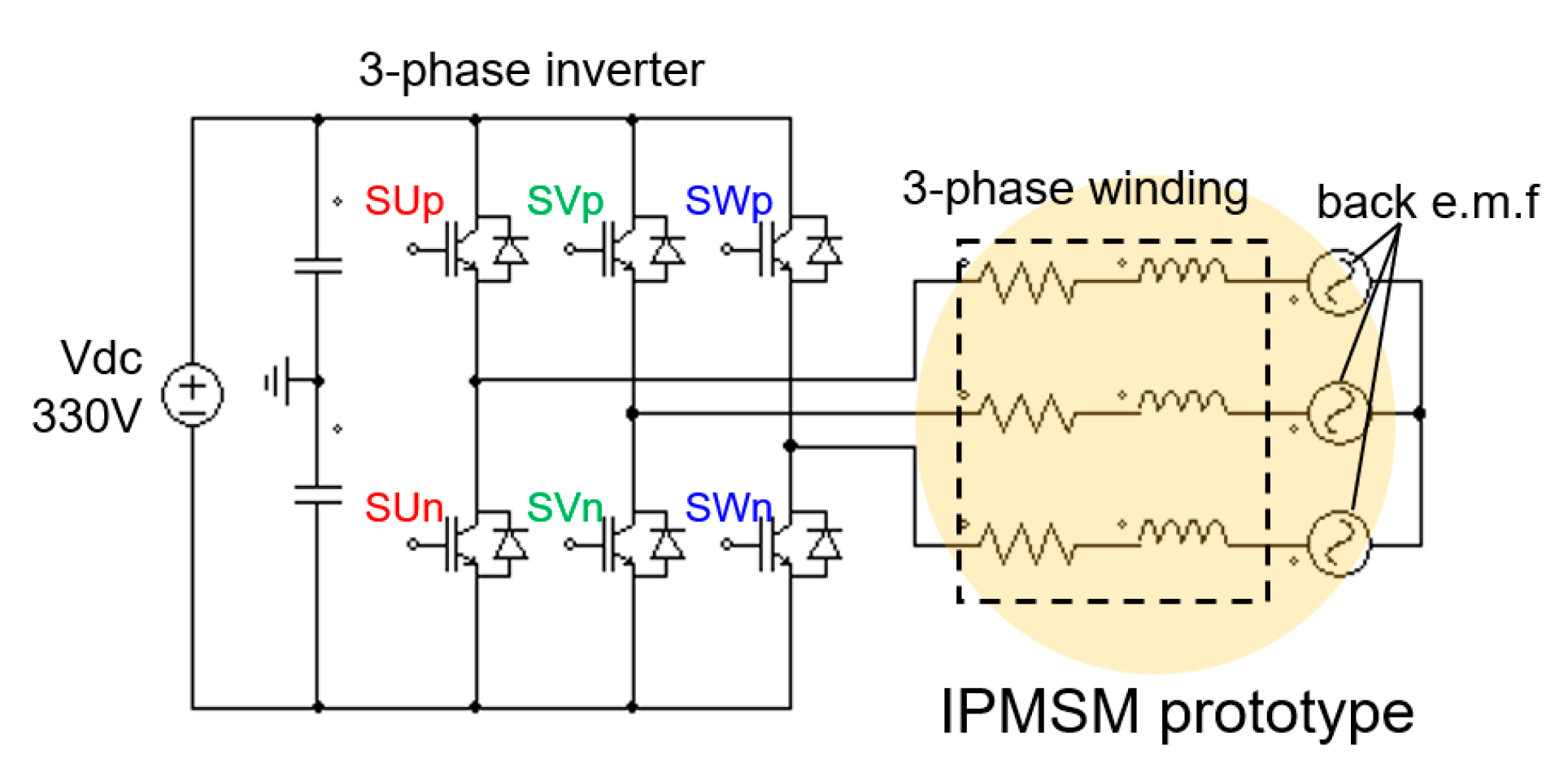

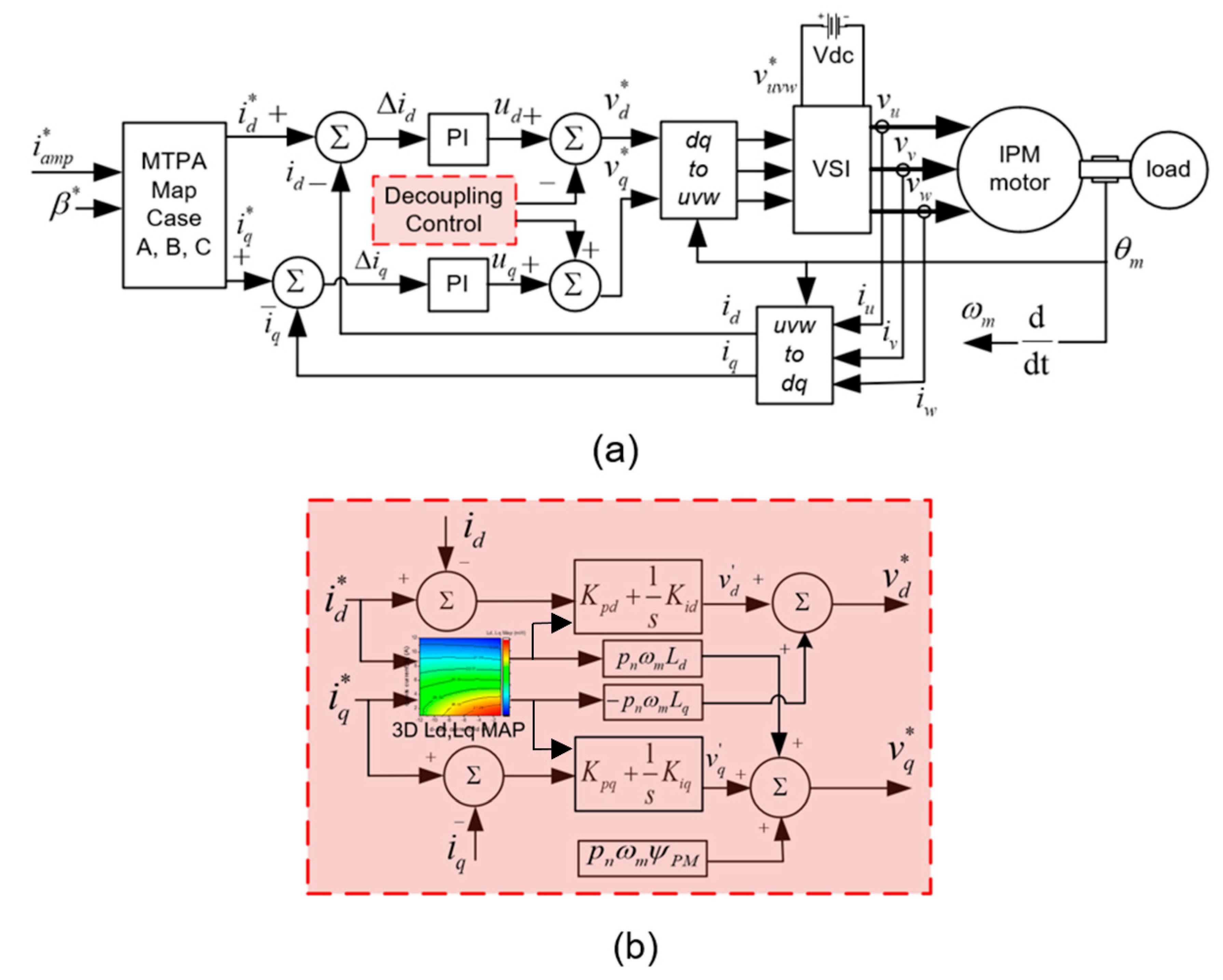
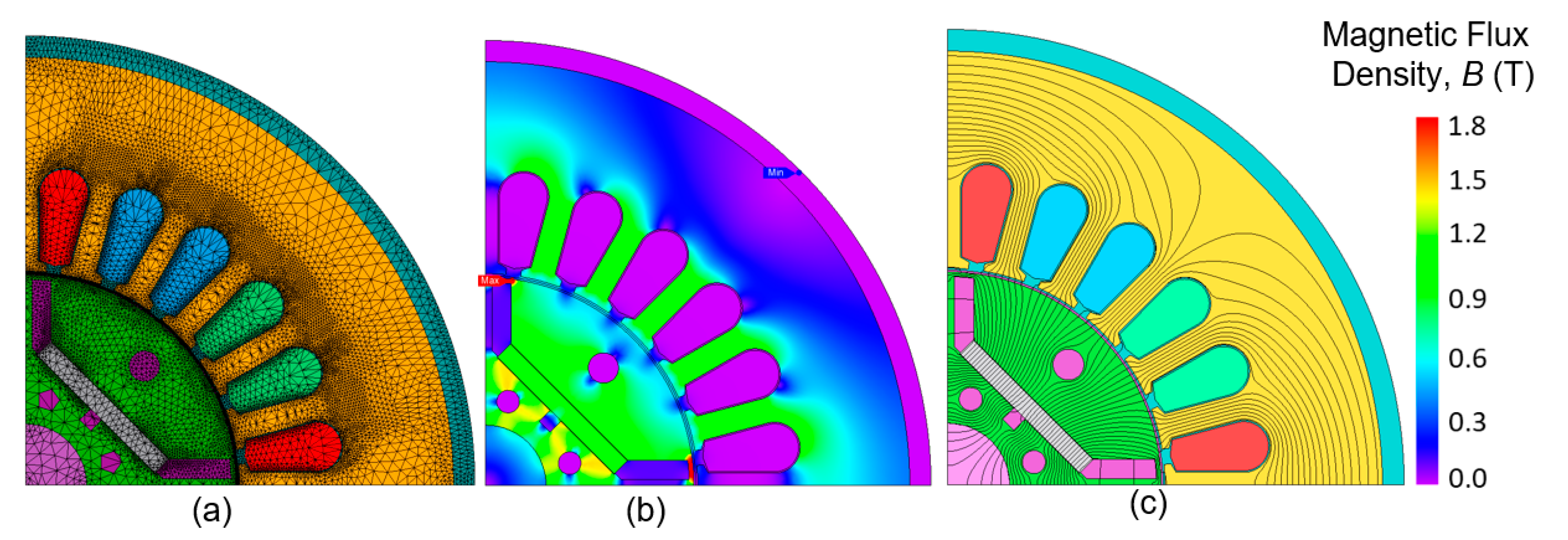

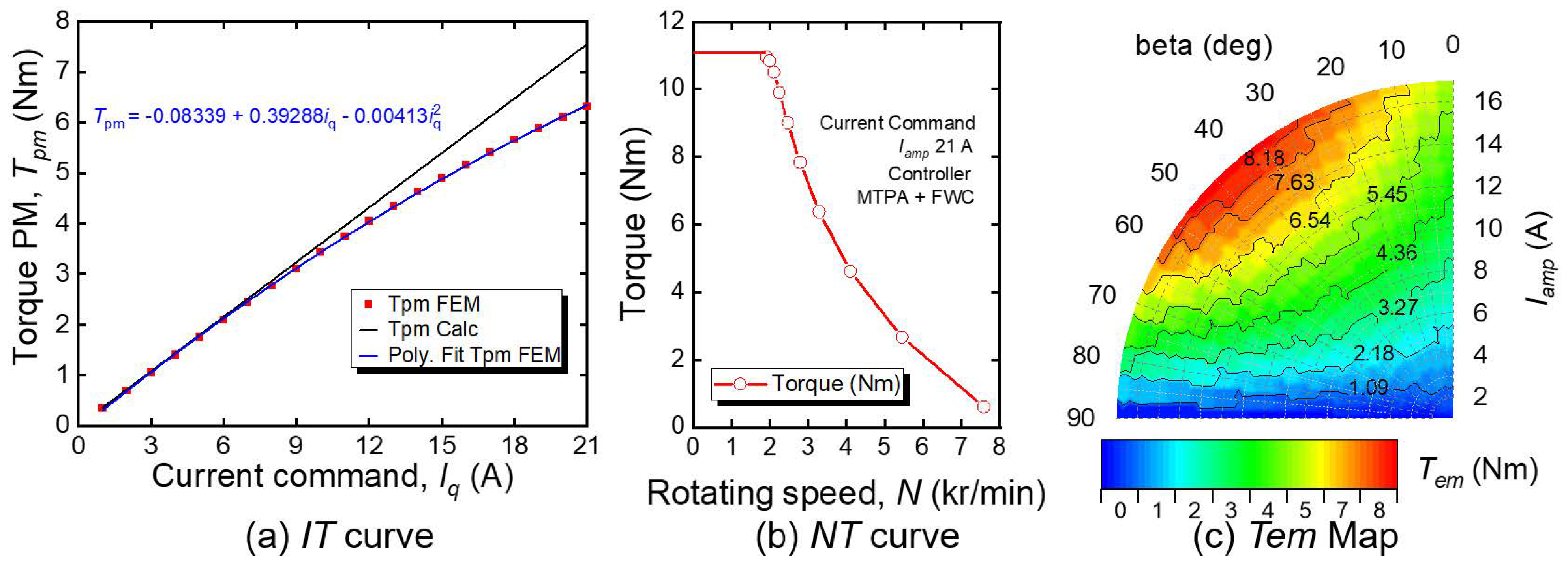
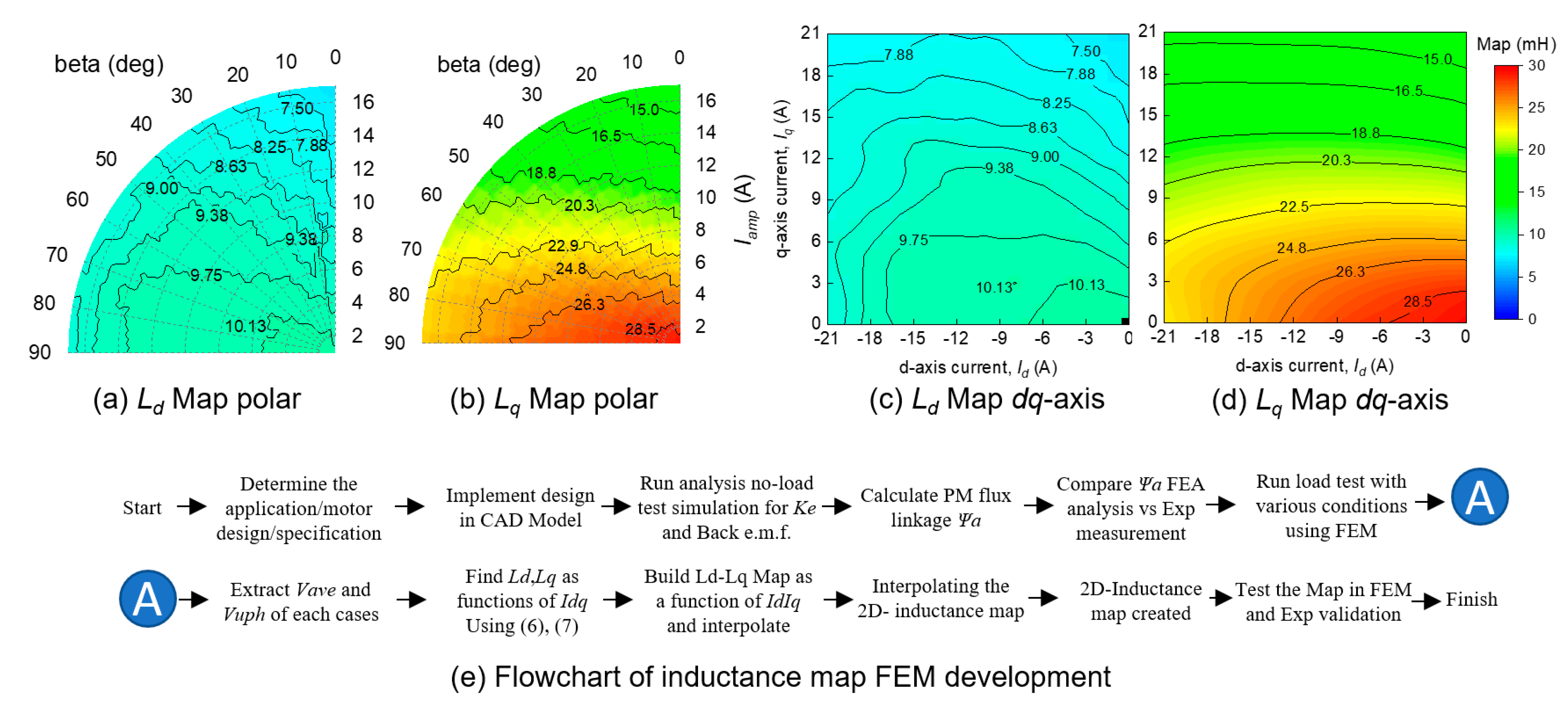
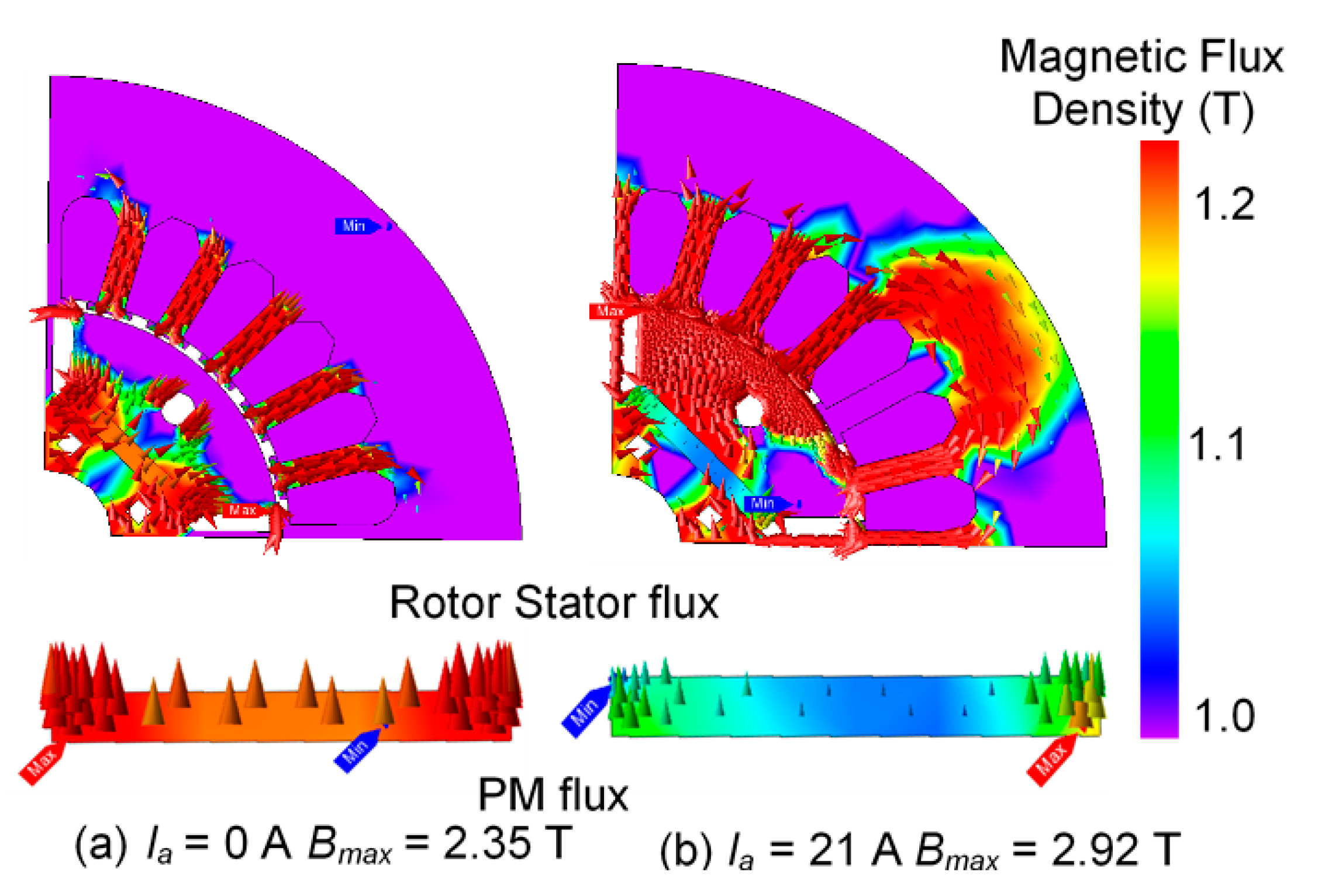
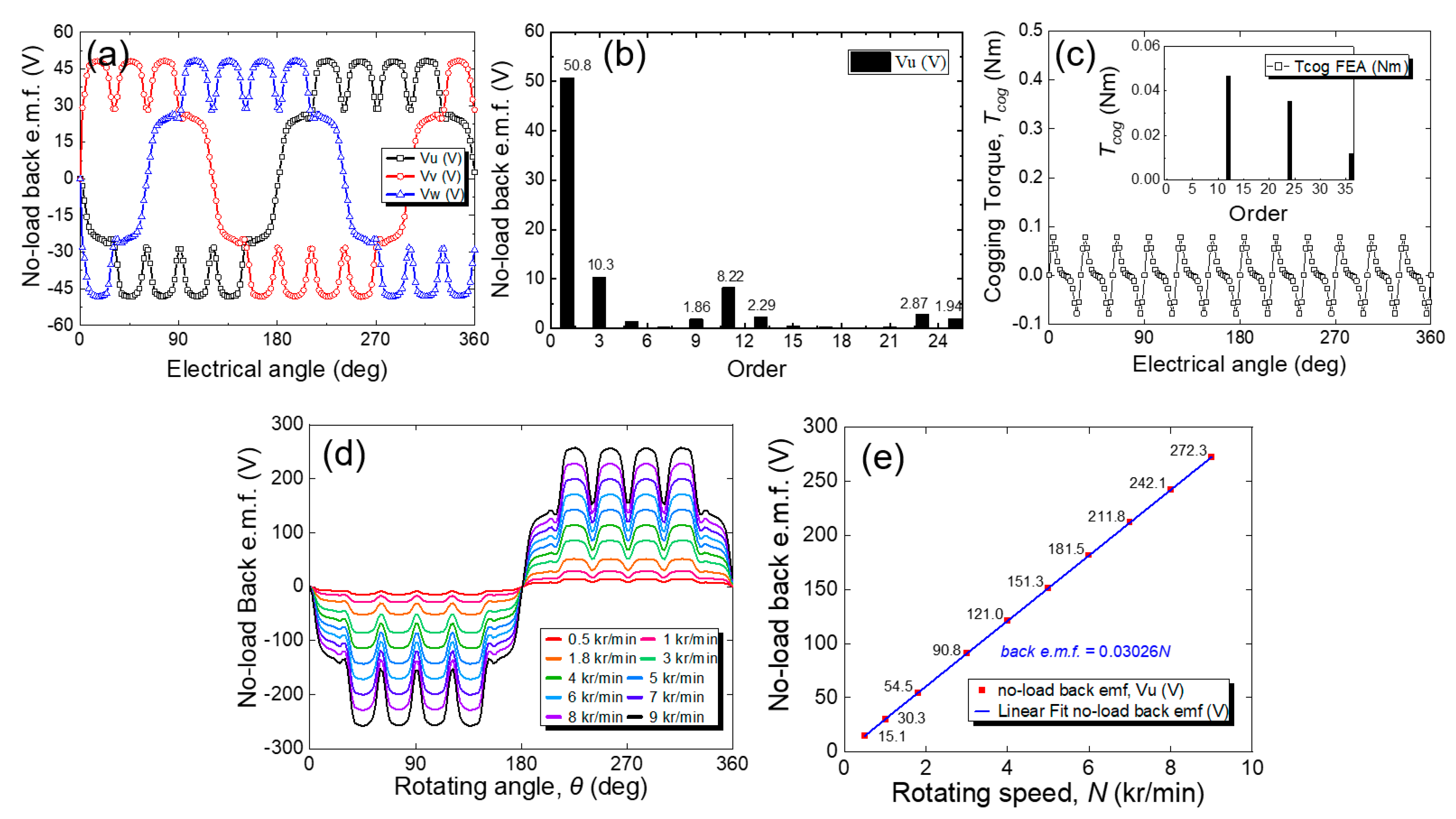
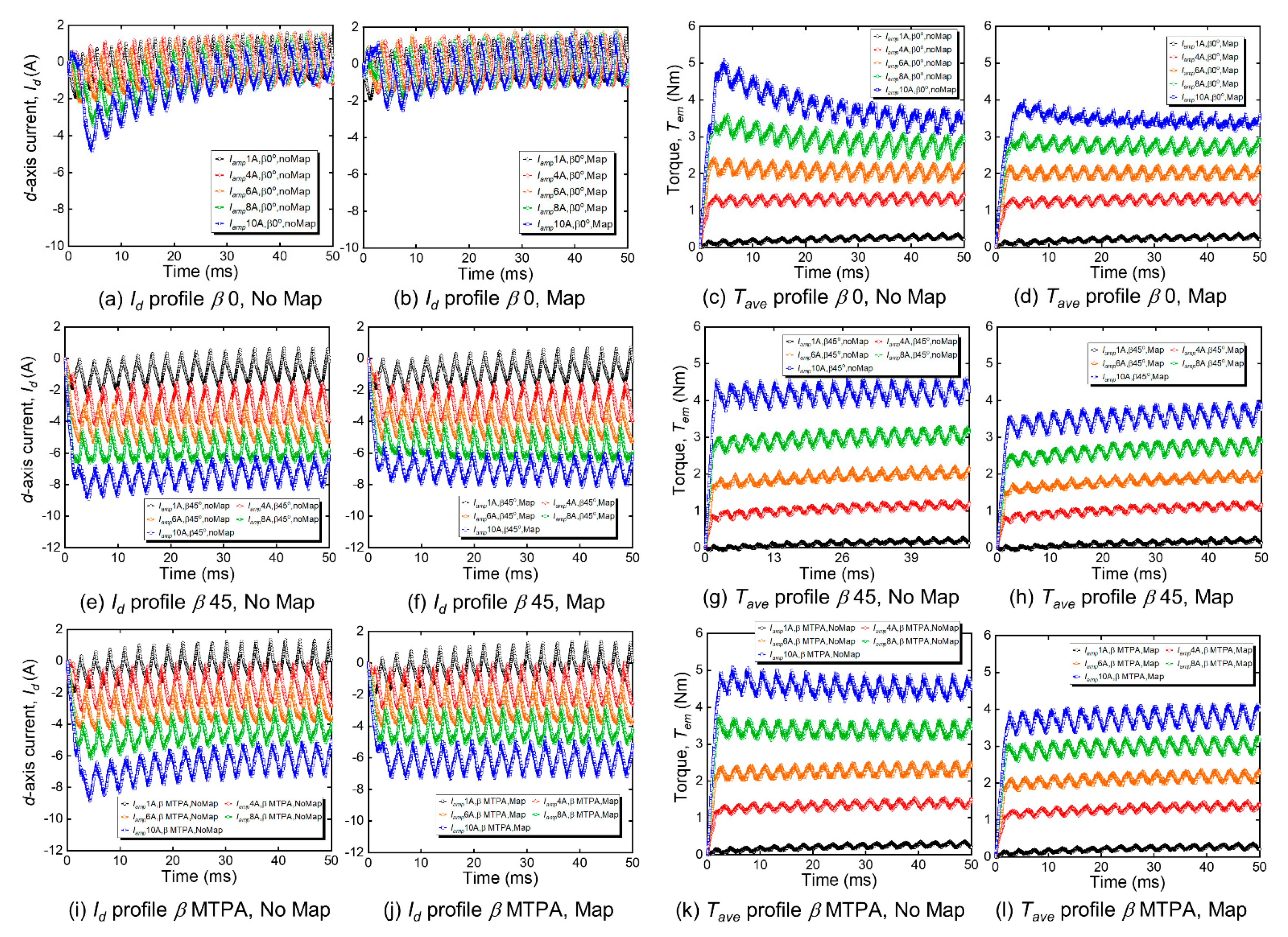


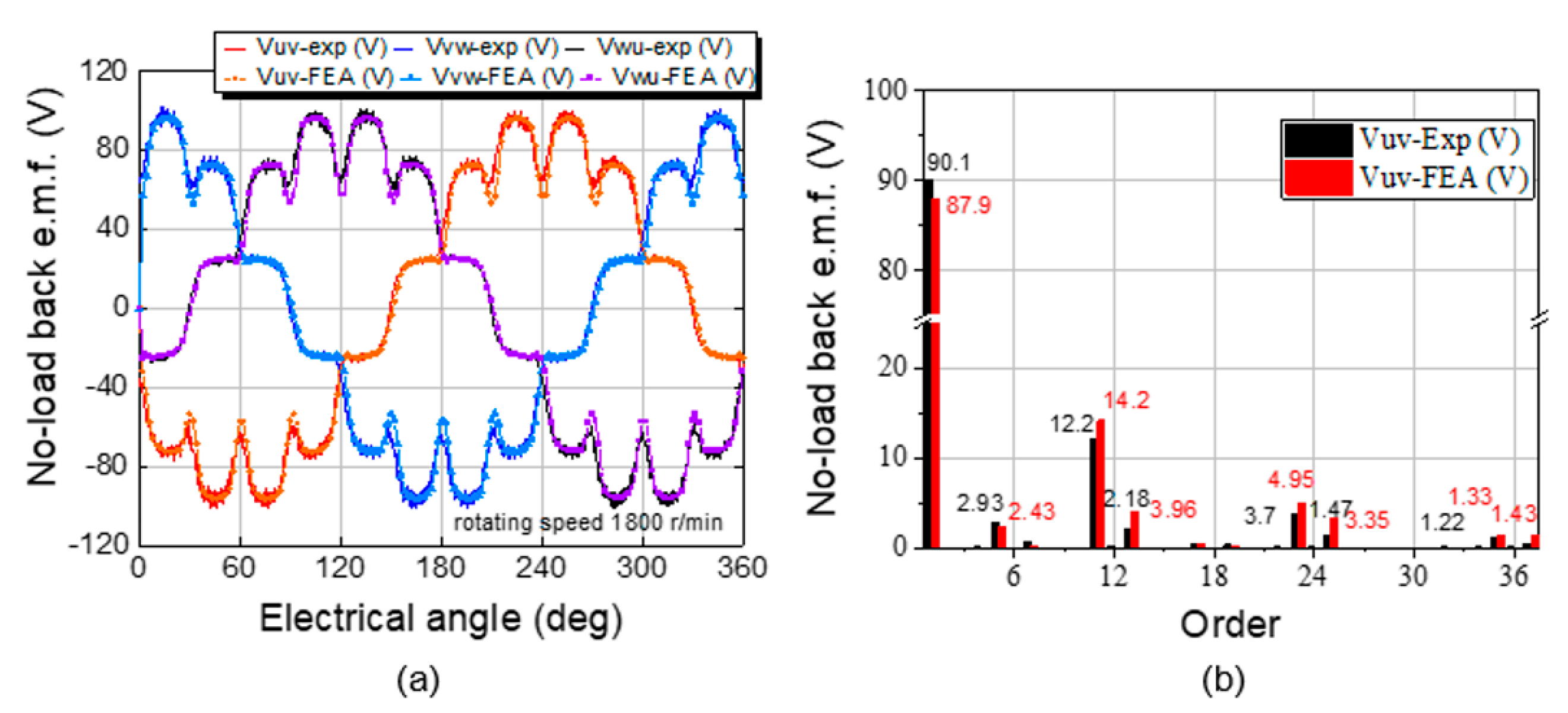
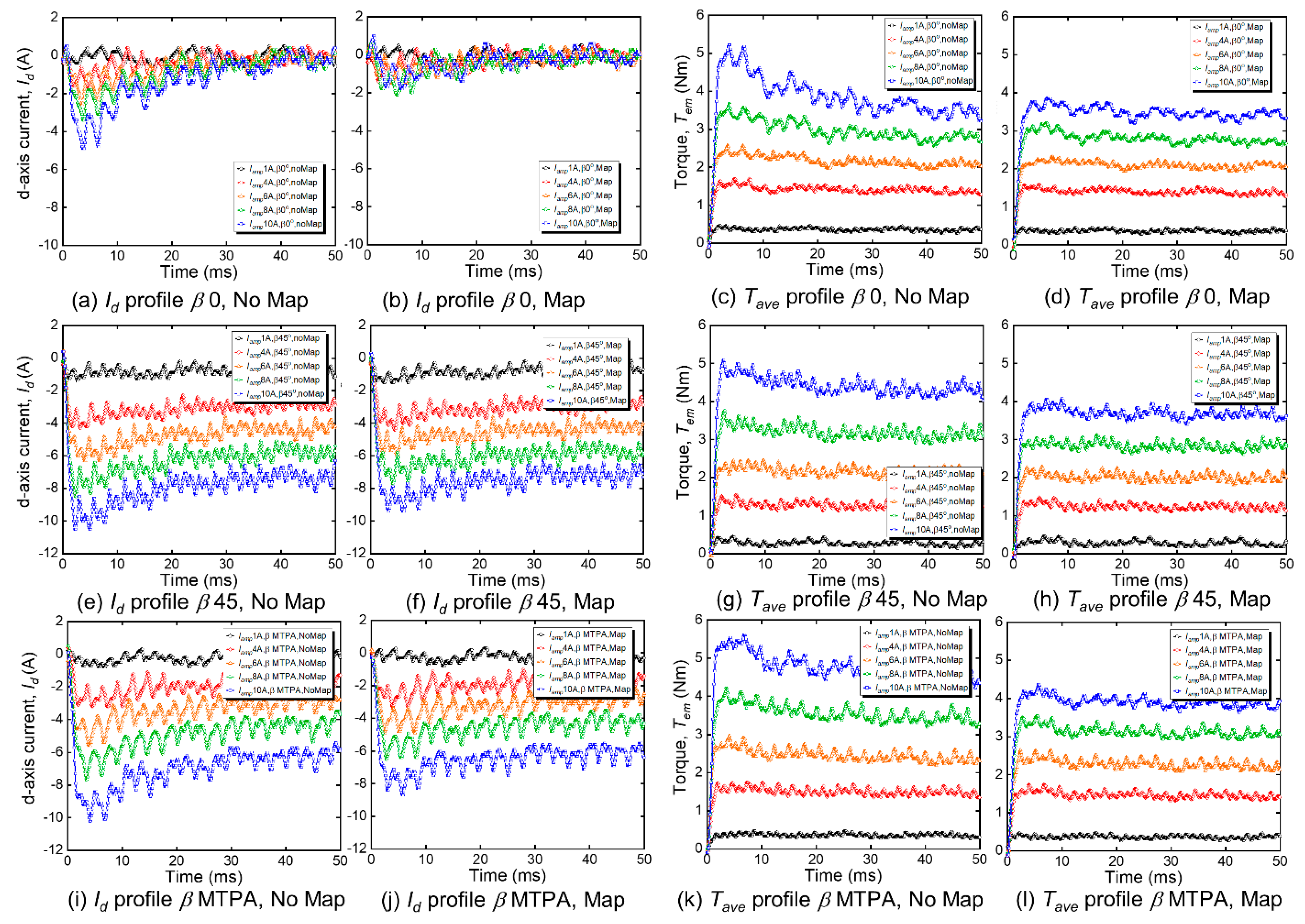




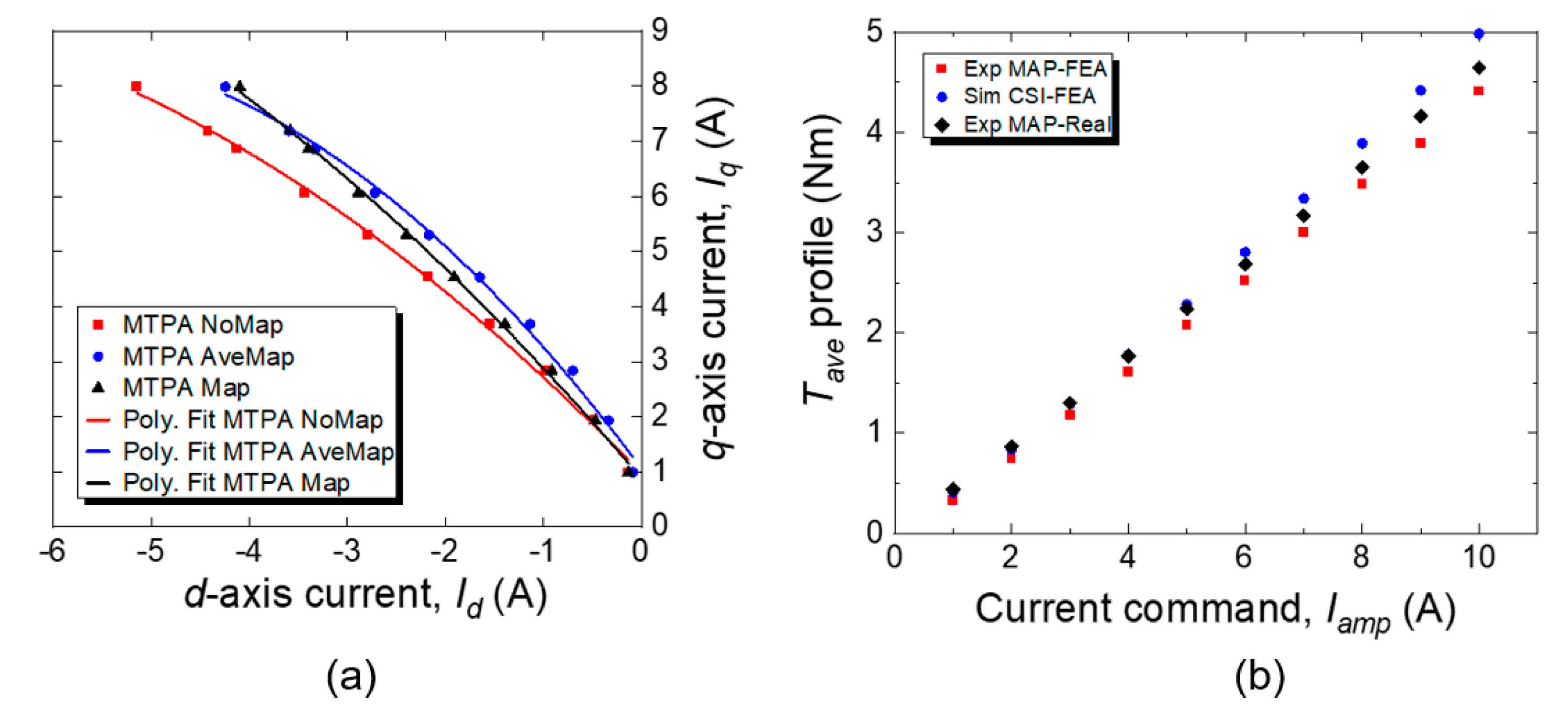
| Motor Specification | Value | Unit (SI) |
|---|---|---|
| DC bus voltage (Vdc) | 330 | V |
| Rated current (irated) | 3 | A |
| Stack length | 60 | mm |
| Rotating speed (N) | 1800 | r/min |
| Stator resistance (Ra) | 0.851 | Ω |
| d-axis inductance (Ld) | 10.7 | mH |
| q-axis inductance (Lq) | 26.3 | mH |
| Controller Parameters of Inverter | Values |
|---|---|
| Switching freq (Cfeq) | 10 kHz |
| Cutoff freq (ωc) | 1000 rad/s |
| Vdc bus voltage (Vdc) | 330 Vdc |
| Gain Kp d-axis (Kpd) | ωcLd(idiq) |
| Gain Kp q-axis (Kpq) | ωcLq(idiq) |
| Gain Ki (Ki) | ωcRa |
Disclaimer/Publisher’s Note: The statements, opinions and data contained in all publications are solely those of the individual author(s) and contributor(s) and not of MDPI and/or the editor(s). MDPI and/or the editor(s) disclaim responsibility for any injury to people or property resulting from any ideas, methods, instructions or products referred to in the content. |
© 2023 by the authors. Licensee MDPI, Basel, Switzerland. This article is an open access article distributed under the terms and conditions of the Creative Commons Attribution (CC BY) license (https://creativecommons.org/licenses/by/4.0/).
Share and Cite
Husnayain, F.; Noguchi, T.; Akaki, R.; Yusivar, F. Improved Current and MTPA Control Characteristics Using FEM-Based Inductance Maps for Vector-Controlled IPM Motor. Energies 2023, 16, 4712. https://doi.org/10.3390/en16124712
Husnayain F, Noguchi T, Akaki R, Yusivar F. Improved Current and MTPA Control Characteristics Using FEM-Based Inductance Maps for Vector-Controlled IPM Motor. Energies. 2023; 16(12):4712. https://doi.org/10.3390/en16124712
Chicago/Turabian StyleHusnayain, Faiz, Toshihiko Noguchi, Ryosuke Akaki, and Feri Yusivar. 2023. "Improved Current and MTPA Control Characteristics Using FEM-Based Inductance Maps for Vector-Controlled IPM Motor" Energies 16, no. 12: 4712. https://doi.org/10.3390/en16124712
APA StyleHusnayain, F., Noguchi, T., Akaki, R., & Yusivar, F. (2023). Improved Current and MTPA Control Characteristics Using FEM-Based Inductance Maps for Vector-Controlled IPM Motor. Energies, 16(12), 4712. https://doi.org/10.3390/en16124712






